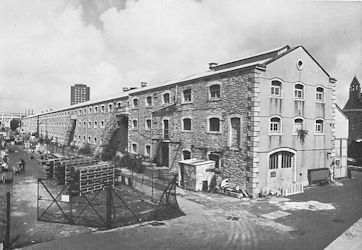|
OLD DEVONPORT
. UK |
||
|
© Brian
Moseley, Plymouth Webpage created: July 13, 2019 Webpage updated: October 26, 2022 |
||
|
EAST ROPE HOUSE (S132)
The East Rope House, South Yard. In the days of the wooden sailing warship, when the Royal Dockyard at Devonport was begun, rope was an integral part of the operation of the sails. To manufacture it a Ropery was built to the south of the First Dock. It ran from east to west and was 1,056 feet long to the surrounding wall of the Royal Dockyard and was 25 feet wide. In fact it ended outside the Yard, which met with strong objections from the tenant of the land beyond the perimeter wall. The Ropery suffered a disastrous fire on the night of July 2nd/3rd 1761 but instead of rebuilding it on the same site, which was blocking expansion of the Yard southwards on to the New Ground acquired just beforehand, it was decided to build two new blocks, running north to south and adjacent to the Dockyard's boundary wall. The eastern block was initially called the Spinning House and was constructed between 1763 and 1771. Here the hemp was spun into twine. The western block was called the Laying House, where the rope was laid out. Unfortunately the Spinning House suffered another huge fire on Monday June 8th 1812. This fire threatened the whole Yard and took five days to bring under control. It destroyed over 900 feet of the East Rope House, which was 1,200 feet long, and was reckoned to have caused around £15,000 of damage, which included the rope twisting machinery. Within five years the Rope House had been rebuilt to the design of Mr Edward Holl (1766-1823), architect to the Navy Board, during which it was given the new name of the East Rope House. He used cast and wrought iron for the framework and roof trusses and York stone slabs for the floor. The walls are of limestone rubble with limestone ashlar dressings. The building is entirely open plan and has 57 bays of three storeys with cellars. There were boiler houses at each end of the building and it was linked by bridges to Tarred Yarn House Number 1 (Store number 26) and Tarred Yard House Number 2 (Store House Number 27). Adjacent to the southern end of the building was the Oakum Store Number 28, and the Mutton Cove Gate with Police Office and the Mortuary. Rope making continued at Devonport until 1941, when the West Rope House was destroyed by enemy bombing. The East Rope House was reduced by almost a third at its northern end after the War. From 1945 until 1969 the building was used as a training centre for shipwright apprentices. They are thought to have been responsible for the creation of the Hangman's noose and drop floor which has become something of a tourist attraction. The East Rope House is a Scheduled Ancient Monument.
|
||
